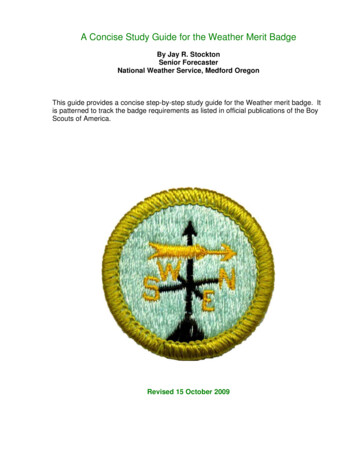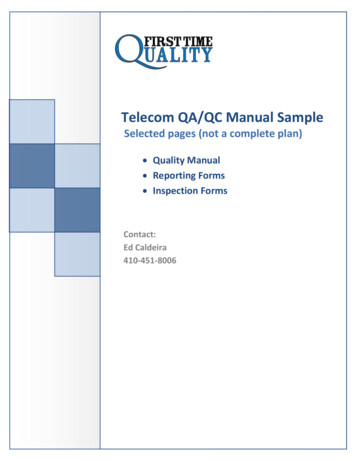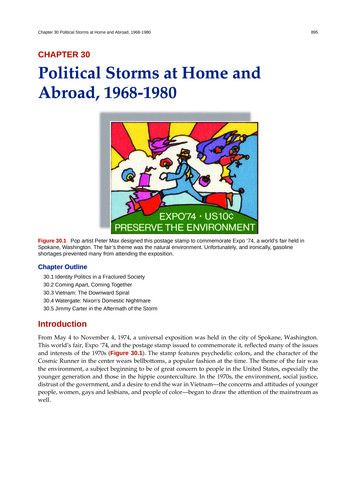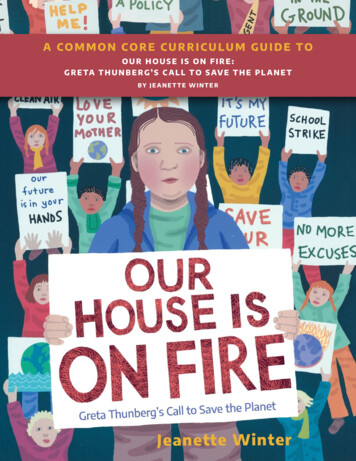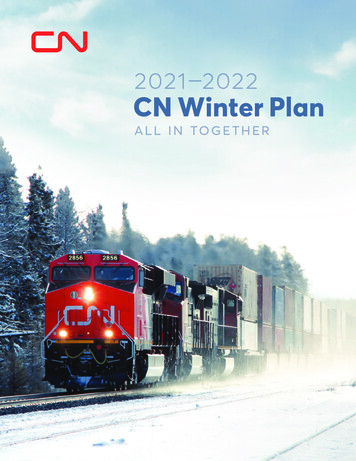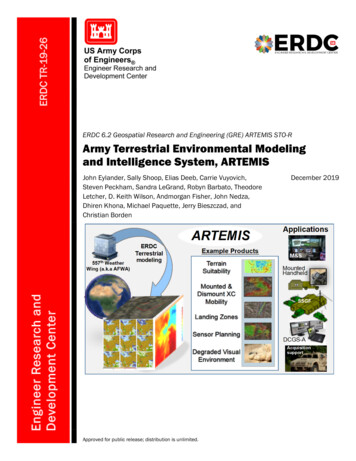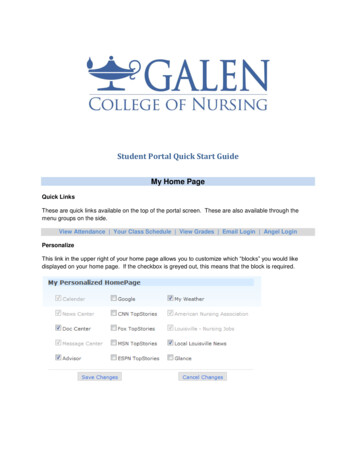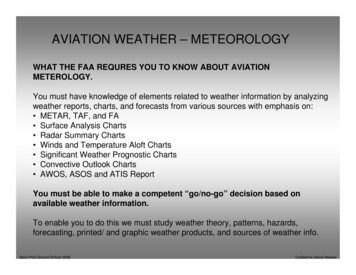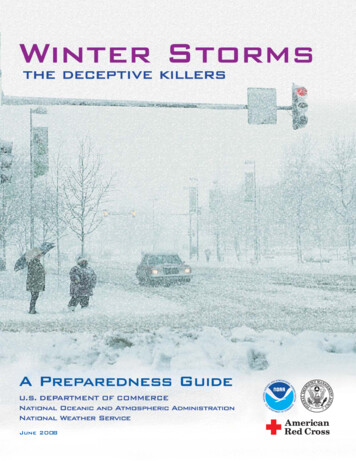
Transcription
June 2008
Winter StormsThe Deceptive KillersThis preparedness guide explains the dangers of winter weather and suggests life-saving action YOUcan take. With this information, YOU can recognize winter weather threats, develop an action plan andbe ready when severe winter weather threatens. Remember your safety is up to YOU.Why Talk About Winter Weather? Each year, dozens of Americans die due to exposure to cold. Add to that number, vehicle accidentsand fatalities, fires due to dangerous use of heaters and other winter weather fatalities and you havea significant threat. Threats, such as hypothermia and frostbite, can lead to loss of fingers and toes or cause permanentkidney, pancreas and liver injury and even death. You must prepare properly to avoid these extremedangers. You also need to know what to do if you see symtoms of these threats. A major winter storm can last for several days and be accompanied by high winds, freezing rain orsleet, heavy snowfall and cold temperatures. People can become trapped at home or in a car, without utilities or other assistance. Extremely cold temperatures, heavy snow and coastal flooding can cause hazardous conditionsand hidden problems.Attempting to walk for help in a winter storm can be a deadly decision.The aftermath of a winter storm can have an impact on a community or region for days, weeksor even months.For More InformationContact your local National Weather Service (NWS) office,American Red Cross chapter or local emergency managementagency for more weather-related brochures.You can find more information on flash flooding in the Floods The Awesome Power brochure. Contact your local Red Crosschapter or NWS office for copies. You can download a copy atthis NWS Web site rochure 02 06.pdf. To find additional materials onwinter safety, try the following Web sites:NWS: www.nws.noaa.govFEMA: www.fema.govRed Cross: www.redcross.orgJames Wiesmueller2
Heavy SnowHeavy snow can immobilize a region and paralyze a city, stranding commuters, closing airports, stoppingthe flow of supplies, and disrupting emergency and medical services. Accumulations of snow can cause roofsto collapse and knock down trees and power lines. Homes and farms may be isolated for days and unprotectedlivestock may be lost. In the mountains, heavy snow can lead to avalanches. The cost of snow removal,repairing damages, and the loss of business can have severe economic impacts on cities and towns.BLIZZARD: Winds of 35 mph or more with snow andblowing snow reducing visibility to less than¼ mile for 3 hours or more.BLOWING SNOW: Wind-driven snow that reduces visibility.Blowing snow may be falling snow and/orsnow on the ground picked up by the wind.SNOW SQUALLS: Brief, intense snow showers accompaniedby strong, gusty winds. Accumulation maybe significant.SNOW SHOWERS: Snow falling at varying intensities for brief periodsof time. Some accumulation is possible.SNOW FLURRIES: Light snow falling for short durations with littleor no accumulation.Injuries Due To Ice and Snow About 70% result from vehicle accidentsBefore and after photo at Mt. Baker, WA,Ski Summit. Early June snow depth in 1999measured 228 inches. The world recordseasonal snowfall of 1,141 inches wasrecorded at Mt. Baker that year.Photos courtesy of Mt. Baker Ski Area. About 25% occur in people caught out in a storm Most happen to males over 40 years oldAn avalanche is a mass of tumbling snow. More than 80 percentof midwinter avalanches are triggered by a rapid accumulation ofsnow, and 90 percent of those occur within 24 hours of snowfall.An avalanche may reach a mass of a million tons and travel atspeeds up to 200 mph.NWS3
IceHeavy accumulations of ice can bring down trees and topple utility poles and communication towers.Ice can disrupt communications and power for days while utility companies repair extensive damage.Even small accumulations of ice can be extremely dangerous to motorists and pedestrians. Bridgesand overpasses are particularly dangerous because they freeze before other surfaces.RainFrozen precipitationmelts into rainFreezing RainSleetFrozen precipitationmelts in warm air Frozen precipitationmelts rain falls and freezes oncold surfaces as a sheet of ice refreezes into sleetbefore hitting groundSnowSnow falling intocold air never meltsWinter FloodingWinter storms can generate coastal flooding, ice jams and snow melt, resulting in significant damageand loss of life.COASTAL FLOODS: Winds generated from intense winter storms can cause widespread tidal floodingand severe beach erosion along coastal areas.ICE JAMS: Long cold spells can cause rivers and lakes to freeze. A rise in the water level ora thaw breaks the ice into large chunks which become jammed at man made andnatural obstructions. Ice jams can act as a dam, resulting in severe flooding.SNOW MELT: Sudden thaw of a heavy snow pack often leads to flooding.Large wave action in Marquette Harbor, MI/Jack Pellet4Ship survey of ice in shipping channels/NOAA
ColdWind Chill ChartNOAAExposure to cold can causefrostbite or hypothermia andbecome life-threatening. Infantsand elderly people are mostsusceptible. What constitutesextreme cold varies in differentparts of the country. Inthe South, near freezingtemperatures are consideredextreme cold. Freezingtemperatures can causesevere damage to citrus fruitcrops and other vegetation.Pipes may freeze and burst inhomes that are poorly insulatedor without heat. In the North,extreme cold meanstemperatures well below zero.Wind Chill is not the actual temperature but rather how wind and cold feel on exposed skin. As the windincreases, heat is carried away from the body at an accelerated rate, driving down the body temperature.Animals are also affected by wind chill; however, cars, plants and other objects are not.Injuries Related to Cold 50% happen to people over 60 years old More than 75% happen to males About 20% occur in the homeFrostbite is damage to body tissue caused byextreme cold. A wind chill of -20 Fahrenheit (F) willcause frostbite in just 30 minutes. Frostbite causesa loss of feeling and a white or pale appearance inextremities, such as fingers, toes, ear lobes or the tipof the nose. If symptoms are detected, get medicalhelp immediately! If you must wait for help, slowlyrewarm affected areas. However, if the person is alsoshowing signs of hypothermia, warm the body corebefore the extremities.Hypothermia is a condition brought on whenthe body temperature drops to less than 95 F. Itcan kill. For those who survive, there are likely to belasting kidney, liver and pancreas problems. Warningsigns include uncontrollable shivering, memoryloss, disorientation, incoherence, slurred speech,drowsiness and apparent exhaustion. Take theperson’s temperature. If below 95 F, seek medicalcare immediately!If Medical Care is Not Available,Hypothermia occurswhen the extremitiesare excessivelycold (blue)Improperly warming thebody will drive cold bloodfrom the extremities to theheart, leading to heartfailurewarm the person slowly, starting with the body core.Warming the arms and legs first drives cold bloodtoward the heart and can lead to heart failure. Ifnecessary, use your body heat to help. Get the personinto dry clothing and wrap in a warm blanket coveringthe head and neck. Do not give the person alcohol,drugs, coffee or any hot beverage or food. Warm brothis the first food to offer.5
Winter Storm HaAlaska Heavy snow Strong winds/Blizzards Coastal flooding Extreme cold Avalanches Ice jams Ice fogThe West Coast Heavy precipitation High winds Coastal flooding Beach erosionInchesThe Rockies Heavy snow Mountain-effect snow Strong winds Avalanches Extreme cold Blizzards6
zards in the U.S.Annual Mean SnowfallMidwest and Plains Heavy snow Strong winds/Blizzards Extreme wind chill Lake-effect snow Ice stormsMid-Atlanticto New England Heavy snow Ice storms Strong winds Coastal flooding Beach erosion Extreme coldSoutheast andGulf Coast Ice storms Crop-killing freezes Occasional snow7
How Winter Storms FormThere are many ways for winter storms to form; however, all have three key components.COLD AIR: For snow and ice to form, the temperature must be below freezingin the clouds and near the ground.MOISTURE: Water evaporating from bodies of water, such as a large lake orthe ocean, is an excellent source of moisture.LIFT: Lift causes moisture to rise and form clouds and precipitation. Anexample of lift is warm air colliding with cold air and being forcedto rise. Another example of lift is air flowing up a mountain side.Warm FrontCold FrontLake EffectWarmAirMountain EffectWarmerAirCold AirCold AirWarmAirArcticAirHeat & Moisture8Cold Land
Stay Informed!KEEP AHEADOF THE STORMby listening toNOAA Weather Radio,commercial radioand television for thelatest winter stormwarnings, watchesand advisoriesElectronic equipment available to receive weather information/NOAA(Weather Radio, Radio, TV, Pager, Cell Phone, Two-Way Radio)NOAA Weather Radio is the best means to receive warnings from the NationalWeather Service. The National Weather Service continuously broadcasts warnings and forecaststhat can be received by NOAA Weather Radios, which are sold in many stores. The average range is40 miles, depending on topography. Purchase a radio that has a battery back-up and a Specific AreaMessage Encoder feature, which automatically alerts you when a watch or warning is issued for yourcounty or parish.What to Listen ForThe National Weather Service issues outlooks, watches, warnings and advisories for all winter weatherhazards. Here’s what they mean and what to do. Use the information below to make an informed decisionon your risk and what actions should be taken. Remember to listen to your local officials’ recommendationsand to NOAA Weather Radio for the latest winter storm information.OUTLOOK: Winter storm conditions are possible in the next 2-5 days.Stay tuned to local media for updates.WATCH: Winter storm conditions are possible within the next 36-48hours. Prepare now!WARNING: Life-threatening severe winter conditions have begun or willbegin within 24 hours. Act now!ADVISORY: Winter weather conditions are expected to cause significantinconveniences and may be hazardous. If you are cautious,these situations should not be life threatening.9
Be Prepared!Before the Storm StrikesAt Home and WorkIn VehiclesOn the Farm/PetsPrimary concerns are loss of heat,power and telephone service and ashortage of supplies if storm conditionscontinue for more than a day.Plan your travel and check the latestweather reports to avoid the storm!Move animals to sheltered areas.Shelter belts, properly laid out andoriented, are better protection forcattle than confining shelters, suchas sheds.Have available:Flashlight and extra batteries.Battery-powered NOAA WeatherRadio and portable radio to receiveemergency information. These maybe your only links to the outside.Extra food and water. Have highenergy food, such as dried fruit, nutsand granola bars, and food requiringno cooking or refrigeration.Extra medicine and baby items.First-aid supplies.Heating fuel. Refuel before you areempty. Fuel carriers may not reachyou for days after a winter storm.Emergency heat source: fireplace,wood stove, space heater. Use properly to prevent a fire. Ventilate properly.Fire extinguisher, smoke alarm. Test smoke alarms once a monthto ensure they work properly.Make sure pets have plenty offood, water and shelter.Fully check and winterize your vehiclebefore the winter season begins.Carry a WINTER STORMSURVIVAL KIT: Mobile phone, charger, batteries Blankets/sleeping bags Flashlight with extra batteries First-aid kit Knife High-calorie, non-perishable food Extra clothing to keep dry Large empty can to use asemergency toilet. Tissues andpaper towels for sanitary purposes Small can and waterproof matchesto melt snow for drinking water Sack of sand or cat litter for traction Shovel Windshield scraper and brush Tool kit Tow rope Battery booster cables Water container Compass and road maps.Keep your gas tank near full toavoid ice in the tank and fuel lines.Avoid traveling alone.Let someone know your timetableand primary and alternate routes.NOAA10Haul extra feed to nearbyfeeding areas.Have water available. Most animalsdie from dehydration in winter storms.Make sure pets have plenty offood, water and shelter.Glenn Field/NOAADressfor the SeasonWear loose, lightweight, warmclothes in layers. Trappedair insulates. Remove layersto avoid perspiration andsubsequent chill. Outergarments should be tightlywoven, water repellent, andhooded. Wear a hat. Halfyour body heat loss can befrom the head. Cover yourmouth to protect your lungsfrom extreme cold. Mittens,snug at the wrist, are betterthan gloves. Try to stay dry.
When CAUGHT in a Winter StormCourtesy of American Red CrossCourtesy of American Red CrossNOAAOutsideIn a VehicleInsideFind shelter:Stay in vehicle:Stay inside: Try to stay dry. You will become quickly disorientedin wind-driven snow and cold. When using alternate heat froma fireplace, wood stove, spaceheater, etc., use fire safeguardsand properly ventilate. Cover all exposed body parts.No shelter: Build a lean-to, windbreak or snowcave for protection from the wind. Run the motor about 10 minuteseach hour for heat. Open the window a little for fresh air toavoid carbon monoxide poisoning.No heat: Make sure the exhaust pipe isnot blocked. Place rocks around the fire toabsorb and reflect heat. Stuff towels or rags in cracksunder doors.Be visible to rescuers: Cover windows at night.Melt snow for drinking water: Turn on the dome light at nightwhen running the engine. Eat and drink. Food providesthe body with energy for producingits own heat. Keep the bodyreplenished with fluids toprevent dehydration. Build a fire for heat and toattract attention. Eating snow will lower yourbody temperature. Tie a colored cloth, preferably red,to your antenna or door. After snow stops falling, raise thehood to indicate you need help.Exercise: From time to time, move arms, legs,fingers and toes vigorously to keepblood circulating and to keep warm. Close off unneeded rooms. Wear layers of loose-fitting,lightweight, warm clothing.Remove layers to avoidoverheating, perspiration andsubsequent chill.AVOID OVEREXERTION, such as shoveling heavy snow, pushing a car or walking indeep snow. The strain from the cold and the hard labor may cause a heart attack. Sweatingcould lead to a chill and hypothermia. Take Red Cross Cardiopulminary Rescue (CPR) andAutomated External Defibrillator (AED) training so you can respond quickly to an emergency.11
Family Disaster PlanPrepare for hazards that affect your area with a Family Disaster Plan. Where will your family be whendisaster strikes? They could be anywhere at work, at school or in the car. How will you find each other?Will you know if your children are safe? Disasters may force you to evacuate your neighborhood or confine youto your home. What would you do if basic services – water, gas, electricity or telephones – were cut off?Steps to TakeGather information about hazards. Contact your local National Weather Service office, emergency management office, and American Red Cross chapter. Find out what type of disasters could occur and how youshould respond. Learn your community’s warning signals and evacuation plans. Assess your risks andidentify ways to make your home and property more secure.IMeet with your family to create a plan. Discuss your plan with your family. Pick two places to meet: a spotoutside your home for an emergency, such as fire, and a place away from your neighborhood in case youcan’t return home. Choose an out-of-state friend as your “family check-in contact” for everyone to call ifthe family gets separated. Discuss what you would do if advised to evacuate.IIImplement your plan.1. Post emergency telephone numbers by the phone.2. Install safety features in your home, such as smoke alarms and fire extinguishers.3. Inspect your home for potential hazards (items that can move, fall, break or catch fire) and correct them.4. Have your family learn basic safety measures, such as CPR, AED and first aid; how to use a fireextinguisher; and how and when to turn off water, gas and electricity in your home.5. Teach children how and when to call 911 or your local Emergency Medical Services number.6. Keep enough supplies in your home for at least 3 days. Assemble a disaster supplies kit. Storethese supplies in sturdy, easy-to-carry containers, such as backpacks or duffle bags. Keep importantdocuments in a waterproof container. Keep a smaller disaster supplies kit in the trunk of your car.IIIA Disaster Supplies Kit Should Include: A 3-day supply of water(one gallon per person,per day) Food that won’t spoil One change of clothing andshoes per person One blanket or sleepingbag per person First-aid kit Prescription medicines Emergency tools Battery-powered NWR Portable radioFlashlight with extra batteriesExtra set of car keysCash and a credit cardSpecial items for infant, elderlyor disabled family members.Practice and maintain your plan. Ensure your family knows meeting places, phone numbers and safety rules.Conduct drills. Test your smoke alarms monthly and change the batteries at least once each year. Testand recharge your fire extinguisher(s) according to manufacturer’s instructions. Replace stored waterand food every 6 months. Contact your local National Weather Service office, American Red Crosschapter or emergency management office for a copy of “Your Family Disaster Plan” (L-191/ARC4466).IVLocal Sponsorship:ARC 4467 June 2008 NOAA/PA 200160
extreme cold means temperatures well below zero. Cold Injuries Related to Cold 50% happen to people over 60 years old More than 75% happen to males About 20% occur in the home 5 NOAA Wind Chill Chart Hypothermia occurs when the extremities are excessively cold (blue) Improperly warming the
